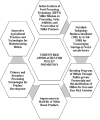Harnessing the potential of millets for climate-resilient and sustainable agriculture
- PMID: 40567416
- PMCID: PMC12188307
- DOI: 10.3389/fpls.2025.1574699
Harnessing the potential of millets for climate-resilient and sustainable agriculture
Abstract
Millets are increasingly gaining global attention for their immense potential to address major challenges such as hunger and malnutrition, and the climatic risks on agricultural production. With the world's population steadily increasing, it is essential to find sustainable solutions for regional food and nutrition security, and support the livelihoods of farmers-especially under changing climate. Among various crops, small millets offer a promising yet underutilized option in the pursuit of food and nutritional security. These crops possess superior nutritional profiles compared to traditional staple cereals and demonstrate exceptional resilience to harsh environmental conditions. They can grow with minimal irrigation and thrive on poor-quality soils. This makes millets ideal for sustainable agriculture in challenging environments. This review highlights the current status of small millets, including their nutritional and health benefits, processing techniques, and recent advancements in genomics. It emphasizes the importance of integrating small millets into mainstream agricultural systems and applying omics technologies to fully realize their potential in combating food insecurity under climate stress. Additionally, the review explores modern genomic and genetic engineering approaches that aim to enhance the climate resilience of small millets. By understanding the molecular basis of these traits, researchers can develop improved varieties with greater adaptability and consistent yields under variable environmental conditions. The comprehensive analysis presented in this review serves as a strategic roadmap for leveraging next-generation technologies to improve key traits in small millets. The ultimate goal is to develop superior varieties that can address the complex challenges of agri-food production system under climate uncertainties. Furthermore, the review outlines pathways to increase the commercial appeal and market viability of millets. By focusing on the development and promotion of small millets, the agricultural sector can take significant steps toward achieving food, nutritional, and economic security in the wake of growing global challenges.
Keywords: climate-resilient; crop alternative; dietary nutrients; food security; millets; underutilized crops.
Copyright © 2025 Mukherjee, Jha, Sattar, Dutta, Bhattacharya, Samanta, Huirem, Singh, Das and Bal.
Conflict of interest statement
The authors declare that the research was conducted in the absence of any commercial or financial relationships that could be construed as a potential conflict of interest.
Figures






Similar articles
-
Enhancing food and nutrition security in Himalayan foothills with neglected and underutilized millets.Sci Rep. 2025 Jan 25;15(1):3182. doi: 10.1038/s41598-024-85090-9. Sci Rep. 2025. PMID: 39863657 Free PMC article.
-
Evolution of agricultural biotechnology is the paradigm shift in crop resilience and development: a review.Front Plant Sci. 2025 Jun 19;16:1585826. doi: 10.3389/fpls.2025.1585826. eCollection 2025. Front Plant Sci. 2025. PMID: 40612601 Free PMC article. Review.
-
Climate Change and Food Production: Small Millets Cultivation Ensures Global Food Supply and Nutritional Security.Plant Cell Environ. 2025 Aug 17. doi: 10.1111/pce.70120. Online ahead of print. Plant Cell Environ. 2025. PMID: 40820434 Review.
-
Accreditation through the eyes of nurse managers: an infinite staircase or a phenomenon that evaporates like water.J Health Organ Manag. 2025 Jun 30. doi: 10.1108/JHOM-01-2025-0029. Online ahead of print. J Health Organ Manag. 2025. PMID: 40574247
-
Unlocking the secrets of zombi pea: a pantropical orphan for a sustainable future.Planta. 2025 Jul 14;262(2):50. doi: 10.1007/s00425-025-04768-0. Planta. 2025. PMID: 40660022 Review.
References
-
- Annor G. A., Marcone M., Corredig M., Bertoft E., Seetharaman K. (2015). Effects of the amount and type of fatty acids present in millets on their in vitro starch digestibility and expected glycemic index (eGI). J. Cereal Sci. 64, 76–81. doi: 10.1016/j.jcs.2015.05.004 - DOI
Publication types
LinkOut - more resources
Full Text Sources

